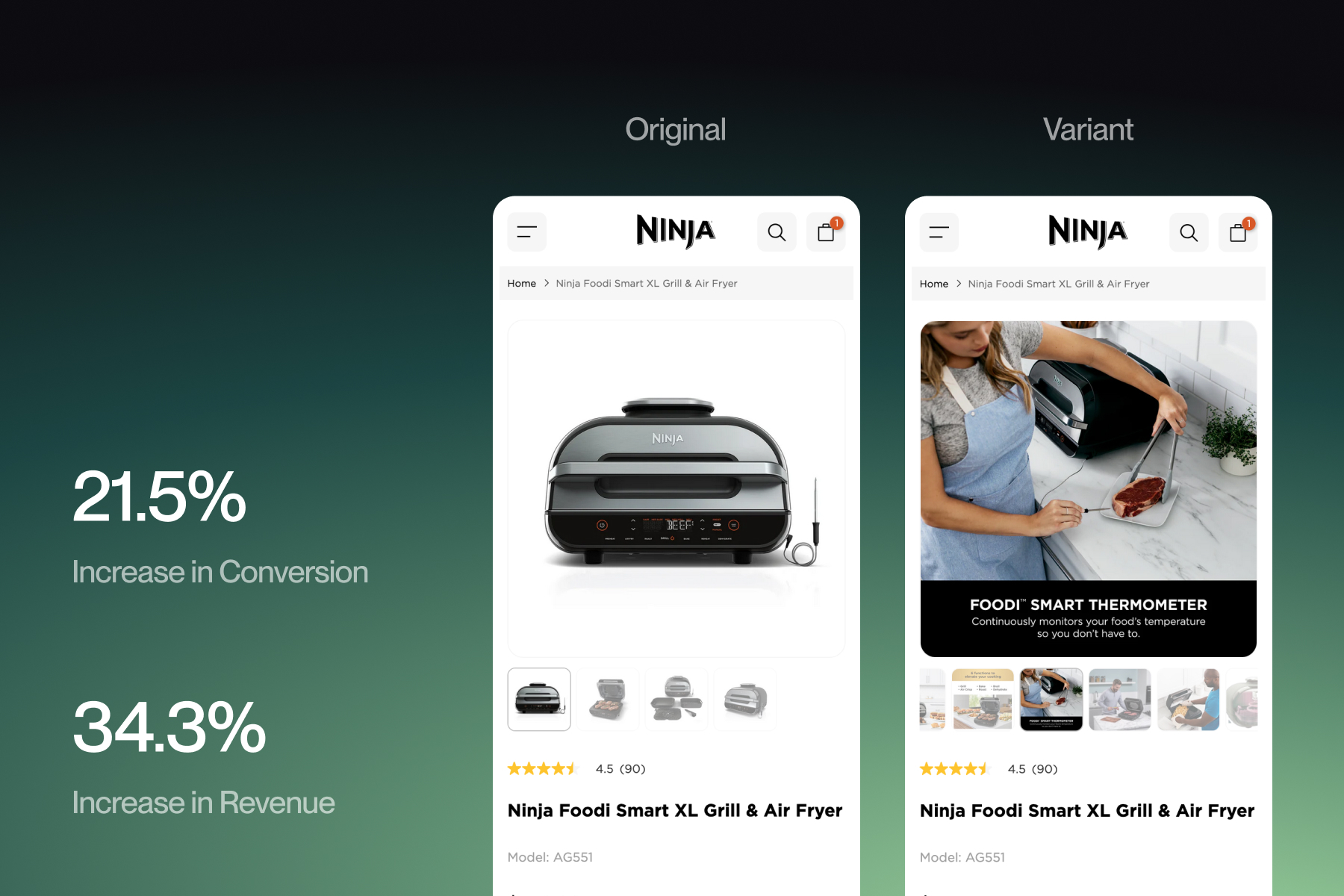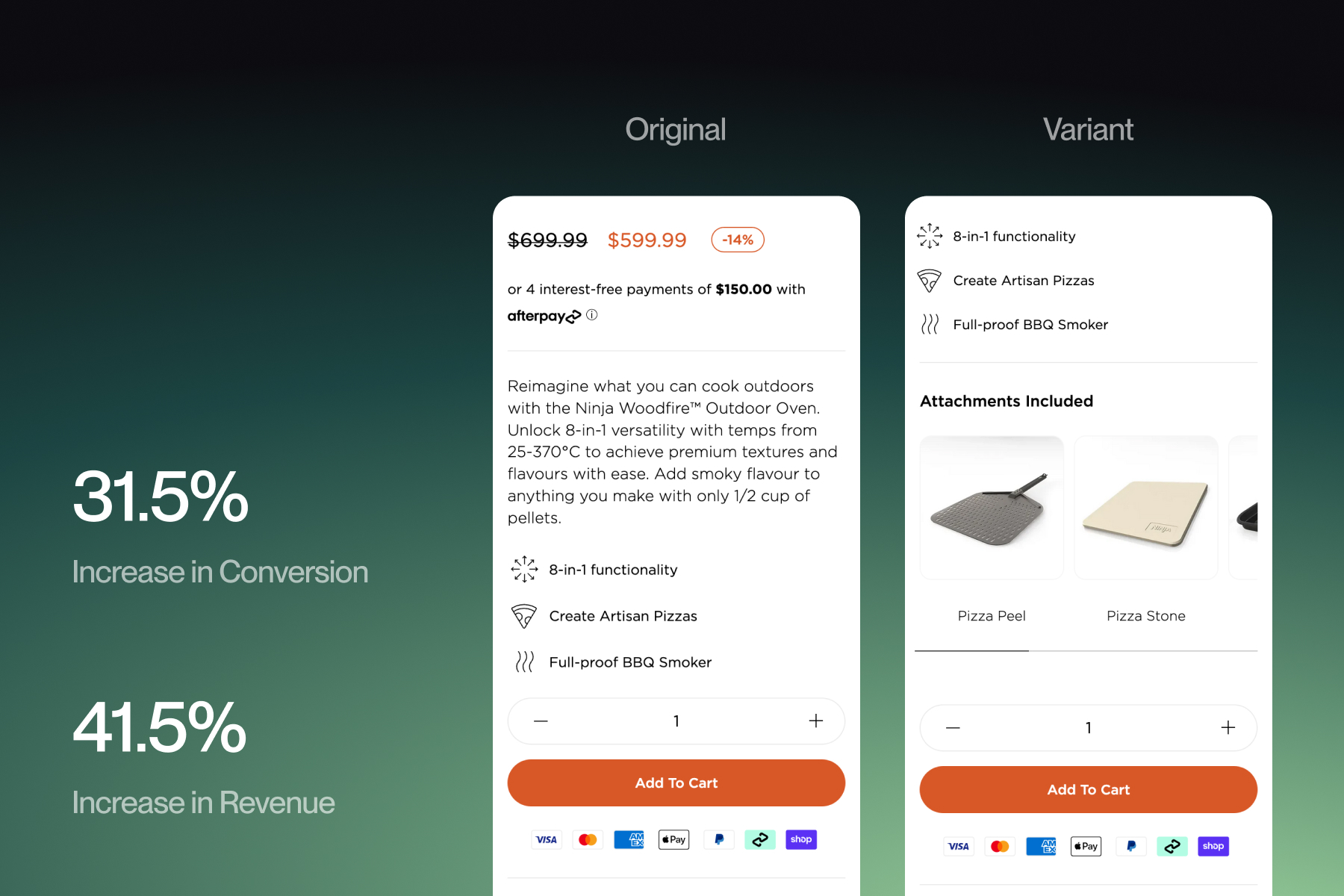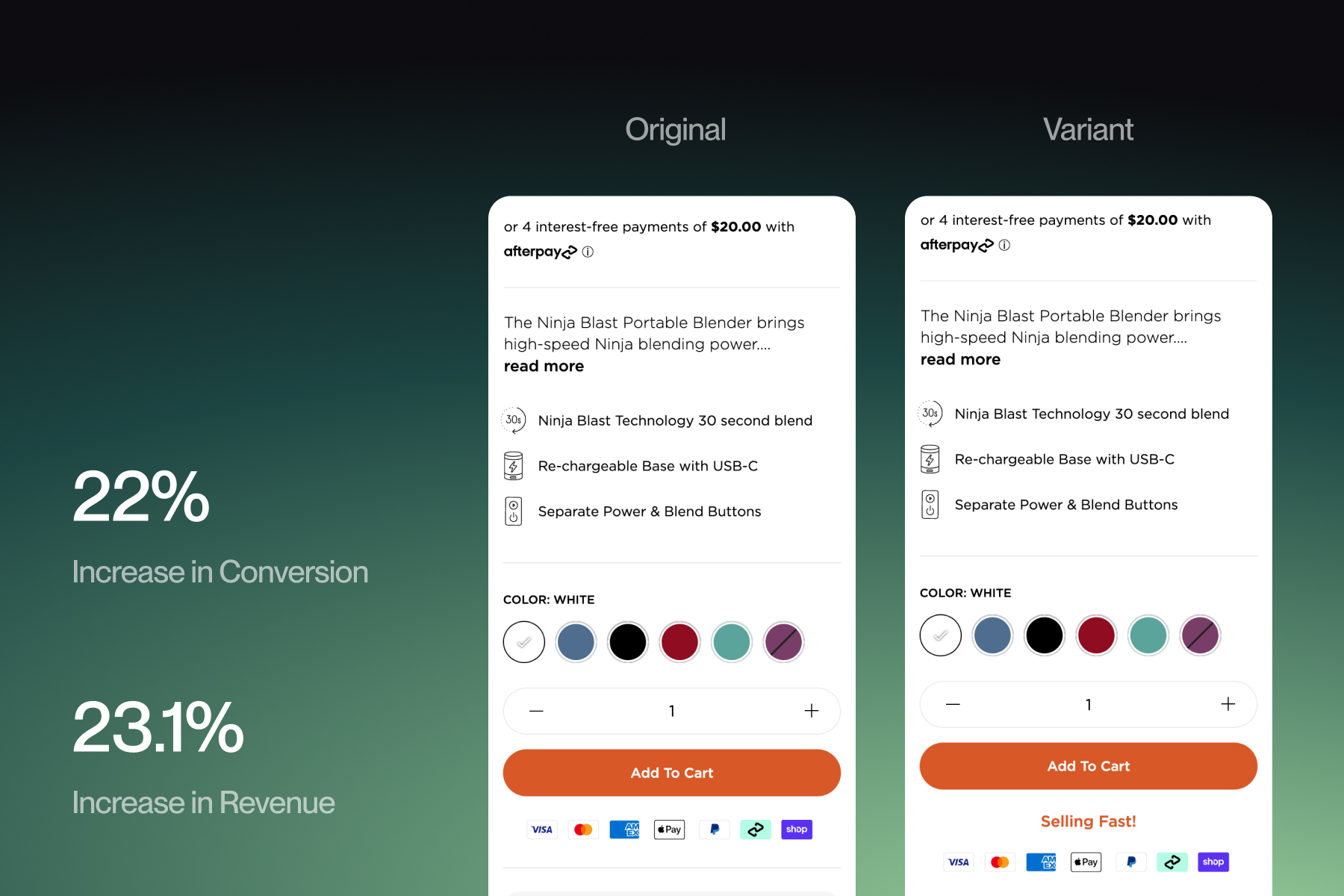Shopify Product Page Testing: 10 CRO Strategies for 2025
This comprehensive guide reveals the 10 most effective product detail page A/B testing experiments of 2025, based on data from thousands of tests conducted through the Shoplift platform. The article covers high-impact optimisations from social proof placement to mobile navigation improvements, explaining why each experiment works and how to implement them systematically for maximum conversion rate and revenue growth.
This article was developed by Process Creative in collaboration with Shoplift, our preferred Shopify A/B testing platform.
Through our partnership with Shoplift, we run controlled experiments across a wide range of industries and store types. Their dataset, built from thousands of brands and more than 10B shopper sessions, gives us a powerful base to validate ideas and uncover what truly moves the needle on PDPs.
The PDP conversion crisis
Your product detail page (PDP) is where browsing intent converts to purchase intent. It's the make-or-break moment for revenue. While most store owners focus relentlessly on driving traffic to their sites, they often ignore a critical reality: their PDP might be losing significant numbers of potential buyers who were already interested enough to click through and view their products.
The standard path: A customer has navigated through your site, found a product they like, and landed on your PDP. They're showing genuine purchase intent. Yet somewhere between viewing your product and clicking "add to cart," you're losing them. The question isn't whether this is happening—it's how much revenue you're leaving on the table when it does.
What We’ve Learned from 10B+ Shopper Sessions with Shoplift
Shoplift is a Shopify A/B testing platform that helps merchants optimise their stores through data-driven experimentation. Their platform has generated insights from thousands of brands running A/B tests across diverse store types and industries, creating a unique dataset of what actually moves the needle on product detail pages.
The data reveals something powerful: individual PDP changes can drive 20-30% conversion improvements. While multiple optimisations have potential for significant impact, A/B testing is essential to determine whether changes complement each other or create conflicts. That's why the experiments outlined below aren't just theoretical—they're battle-tested strategies that have proven their worth across hundreds of real Shopify stores.
Here's the critical point: implementing these changes without proper A/B testing is essentially gambling with your conversion rates. What works for one store might decrease conversions for another due to differences in audience, product type, or brand positioning. A/B testing removes the guesswork by letting your actual customers vote with their wallets. Each experiment should be tested systematically, with proper statistical significance, before making permanent changes to your product pages. Fortunately, tools like Shoplift make this process accessible to any Shopify store owner, regardless of technical expertise.
The Top 10 Game-Changing Experiments
These 10 experiments are ranked based on frequency of positive results and magnitude of conversion improvements observed across Shoplift's testing data. While results vary by industry and audience, these experiments have shown consistent potential across different store types and product categories.
1. Product Gallery Content
Add more images to your gallery that highlight the product's unique selling points and specifications, testing expanded visual storytelling against minimal gallery approaches.
Why it works: Customers can't physically touch your products, so images must tell the complete story. More comprehensive galleries can increase confidence and reduce questions, but they must be curated thoughtfully to avoid overwhelming users.

Case study: Working with our client Ninja Kitchen, the Process Creative team identified that expanding product image galleries to showcase more comprehensive, informative visuals could boost customer confidence and conversion rates. Using Shoplift’s testing platform, we ran an 18-day A/B test to validate this hypothesis. The results confirmed our approach, conversion rate increased by 21.5% and revenue per visitor by 34.3%.
2. What's Included Section
Add a visual "What's Included" section showing users exactly what comes with their purchase. Test package transparency approaches to increase purchase intent and reduce post-purchase confusion.
Why it works: Uncertainty about what's actually included in a purchase creates hesitation and can lead to disappointment after delivery. Clear visual representation of package contents sets proper expectations and can increase perceived value.

Case study: We recommended adding a clear, visual “What’s Included” section to set accurate expectations and highlight value. Using Shoplift, we tested this change over 13 days, resulting in a 30.5% increase in conversion rate and a 41.5% increase in revenue per visitor.
3. Urgency & Scarcity Indicators
Test authentic implementations of low stock alerts, limited-time offers, or "X people viewing" notifications. The key word here is authentic—fake scarcity tactics can backfire spectacularly.
Why it works: Genuine urgency triggers loss aversion, but the implementation must feel trustworthy. Real inventory counts or legitimate time-sensitive offers can push hesitant buyers toward action without damaging brand credibility.

Case study: Using Shoplift, we tested a simple “Selling fast” message near the add-to-cart button, which drove a 22% lift in conversion rate and a 23.1% increase in revenue per visitor.
4. Interactive Size/Fit Guides
Replace static size charts with interactive tools, AR try-ons, or personalised recommendations based on previous purchases.
Why it works: Size uncertainty is one of the biggest barriers to online apparel and footwear purchases. Interactive guides reduce return rates while increasing initial conversion confidence. The key is making the tool feel helpful rather than complicated.
5. Video Integration Strategies
Test auto-play product videos versus click-to-play, placement within the gallery versus a separate section, and lifestyle videos versus product-focused demos. User-generated content apps like Hue and Novel have driven significant conversion uplifts in controlled testing environments.
Why it works: Video content can demonstrate product value in ways that static images cannot. However, the format and placement matter enormously. Auto-play might grab attention, but could also feel intrusive, while UGC videos often outperform professional content because they feel more authentic.
6. Benefit-Focused Unique Selling Points
Add simple, high-visibility reassurance like "365-day returns," "Built to last," or "Satisfaction guaranteed" to reduce hesitation at the moment of purchase. This approach is particularly critical for first-time buyers or high-ticket items.
Why it works: Customers need reassurance about quality, durability, and purchase protection. Clear, benefit-focused unique selling points address common objections before they become abandonment triggers. The key is highlighting benefits rather than just features.
7. Trust Badge Optimisation
Experiment with security badges, guarantee seals, and certification logos, testing placement, quantity, and relevance to your product category.
Why it works: Trust badges can significantly reduce purchase anxiety, but too many badges can look desperate, while too few might miss opportunities for reassurance. The most effective approach varies by product type and customer demographics.
8. Mobile-First Gallery Navigation
Test swipe gestures versus thumbnail navigation, pinch-to-zoom functionality, and full-screen gallery modes specifically designed for mobile users.
Why it works: Mobile commerce continues to grow, but many product galleries still feel like desktop experiences crammed into small screens. Mobile-optimised navigation can dramatically improve the product exploration experience.
9. Social Proof Placement & Format
Test different locations and formats for reviews and ratings. The most successful approaches often involve testing star ratings above the fold versus near the add-to-cart button, or comparing full review snippets against simple star displays.
Why it works: Social proof reduces purchase anxiety, but placement and format dramatically impact its effectiveness. A five-star rating might perform better above the product title for immediate credibility, while detailed review snippets near the add-to-cart button can address last-minute hesitations.
10. Sticky Add-to-Cart Bar on Mobile
Implement a floating add-to-cart button that remains visible as users scroll through your mobile product page.
Why it works: Mobile users often scroll extensively through product images and descriptions. When they're ready to buy, they shouldn't have to scroll back up to find the purchase button. A sticky ATC bar captures impulse purchases and reduces friction at the moment of highest intent.
How we implement these tests with Shoplift
Proper A/B testing setup ensures you get reliable results and avoid making decisions based on statistical noise or seasonal fluctuations. We use Shoplift's Shopify-native capabilities to make these PDP experiments accessible to non-technical store owners through a straightforward four-step process.
1. Create a test and choose a type
Start by creating a new test and selecting the appropriate type for your experiment. You can choose between Template Tests (for specific template or page changes) or Theme Tests (for site-wide elements like headers, footers, or navigation). For most PDP experiments, you'll use template testing to focus on specific product page elements.

2. Select a page or element and create a variant
Choose the specific page or element you want to test, then create your variant. Shoplift's templates and tools like Lift Assist™ help you select optimal variants from the start, taking the guesswork out of what changes might be most effective for your specific situation.

3. Choose a test goal
Select from Shoplift's five key testing goals to measure success:
Average order value: The average revenue generated by each purchase
Conversion rate: The percentage of visitors who make a purchase
Revenue per visitor: The average revenue generated by each visitor (recommended for most tests)
Clickthrough rate: The percentage of visitors who proceed to other pages on your site
Add-to-cart rate: The percentage of visitors who add an item to their cart
If you’re not sure which goal to choose from Shoplift makes every test goal available in your test reports page.

4. Target your audience
Define who sees your test by choosing device types, new versus returning visitors, and other segments based on UTM parameters, URL strings, referring domains, and geographic parameters like country. This targeting ensures your test results reflect the specific audience segments most relevant to your business goals. To learn more about how to target a relevant audience, check out Shoplift’s guide to custom audiences.

5. Preview and launch your test
Before going live, preview your test variants to ensure everything displays correctly across different devices and scenarios. Once you're satisfied with how the changes look and function, launch your test and let it run until you reach statistical significance. Shoplift will track your chosen metrics in real-time, allowing you to monitor progress and make data-driven decisions about implementing successful changes permanently.
Your PDP optimisation roadmap
Start with high-impact, low-risk tests. Begin with experiments that have shown consistent positive results across different store types, like social proof placement or mobile sticky add-to-cart bars. These changes typically have minimal downside risk while offering significant upside potential.
Build a testing culture within your organisation. Systematic PDP optimisation requires ongoing experimentation rather than one-time changes. Successful stores treat testing as a continuous process, constantly learning about their customers and refining their approach based on data rather than assumptions. Platforms like Shoplift make it easy to maintain this testing momentum by providing the tools and insights needed to run experiments consistently without overwhelming your team.
Remember, your product detail page is often the final moment before purchase. Every element should work toward reducing friction, building confidence, and making the buying decision as easy as possible for your customers. The brands that master this process don't just see better conversion rates—they build more profitable, sustainable businesses.
Ready to get started with your PDP optimisation efforts? For a limited time, claim this exclusive offer from Process Creative + Shoplift:
Process Creative is offering a free, 1-hour conversion audit for your PDPs or any other page on your site, available to established merchants generating AUD $2.5M+ in annual revenue and meeting our partner criteria.
Shoplift is offering Process Creative clients an extended free trial of the platform